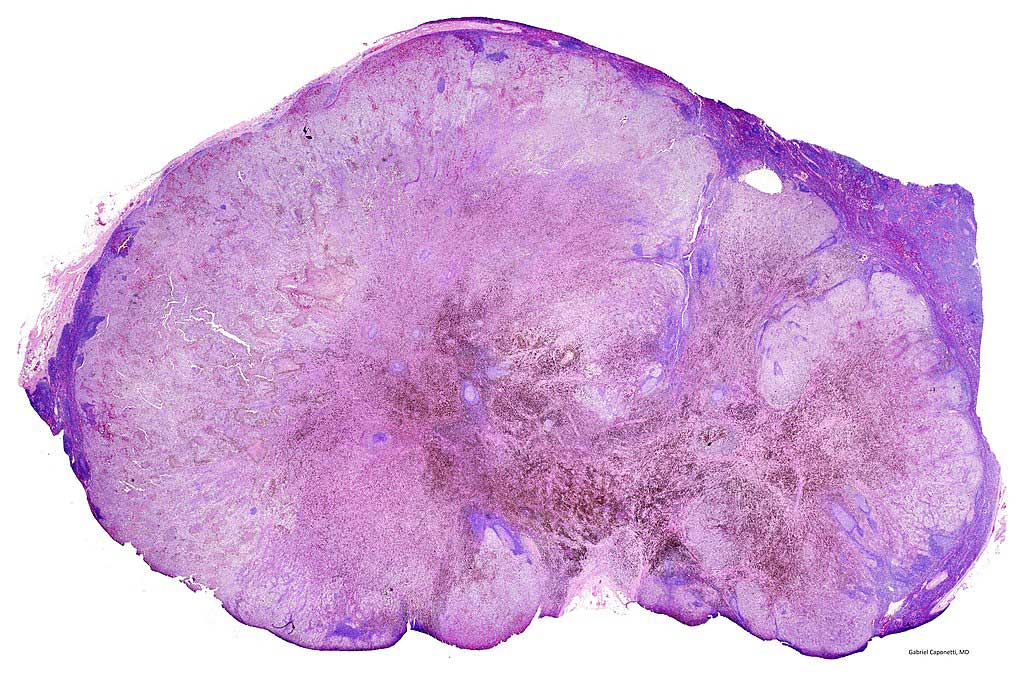Assessment of Circulating Tumor Cells Identifyies Stage III Melanoma Patients at Risk for Relapse
By LabMedica International staff writers
Posted on 19 Feb 2020
Circulating tumor cells found in liquid biopsy specimens have been shown to be useful biomarkers for identifying stage III melanoma patients at risk for relapse.Posted on 19 Feb 2020
Cancer researchers have recognized that there is a need for sensitive, reproducible biomarkers for stage III melanoma patients to guide clinical decision making. Circulating tumor cells (CTCs) can be detected in melanoma patients; however, there is limited data regarding their significance in stage III disease.

Image: Photomicrograph of a lymph node with almost complete replacement by metastatic melanoma (Photo courtesy of Wikimedia Commons)
The current study - carried out by investigators at The University of Texas MD Anderson Cancer Center (Houston, USA) - to determine if CTCs were associated with early relapse in stage III melanoma was based on earlier research that found that CTCs were associated with relapse in a significant number of breast cancer patients.
For this study, the investigators prospectively assessed CTCs at the time of the patient’s first presentation in a clinic (baseline measurement) for 243 stage III melanoma patients. CTCs were measured using the CellSearch System.
CellSearch is the only [U.S.] Food and Drug Administration-approved platform for CTC isolation. This method is based on the use of iron nanoparticles coated with a polymer layer carrying biotin analogues and conjugated with antibodies against EpCAM (epithelial cell adhesion molecule) for the capture of CTCs. Isolation is coupled to an analyzer to take images of isolated cells upon their staining with specific fluorescent antibody conjugates.
This CellSearch system first enriches the tumor cells immunomagnetically by means of ferrofluid nanoparticles and a magnet. Subsequently, recovered cells are permeabilized and stained with a nuclear stain, a fluorescent antibody conjugate against CD45 (leukocyte marker) and cytokeratins 8, 18 and 19 (epithelial markers). The sample is then scanned on an analyzer which takes images of the nuclear, cytokeratin, and CD45 stains. To be considered a CTC, a cell must contain a nucleus, be positive for cytoplasmic expression of cytokeratin as well as negative for the expression of CD45 marker, and have a diameter larger than five microns. If the total number of tumor cells found to meet the criteria cited above is five or more, a blood sample is positive. In studies done on prostate, breast, and colon cancer patients, median survival of metastatic patients with positive samples was about half the median survival of metastatic patients with negative samples. This system is characterized by a recovery capacity of 93% and a detection limit of one CTC per 7.5 milliliters of whole blood.
Results obtained during the current study revealed that at least one baseline CTC was identified in 90/243 (37%) of the patients. Forty-five (19%), 67 (28%), 118 (49%), and 13 (5%) patients were stage IIIA, IIIB, IIIC, or IIID, respectively. CTC detection was not associated with sub stage or primary tumor characteristics. Therefore, the presence of at least one CTC was independently associated with melanoma relapse, suggesting that CTC assessment may be useful to identify patients at risk for relapse who could derive benefit from adjuvant therapy.
"Our analysis demonstrated that CTC detection was significantly associated with a decrease in relapse-free survival at six months, and persisted at a 54-month longer-term follow-up," said first author Dr. Anthony Lucci, professor of breast surgical oncology and surgical oncology at The University of Texas MD Anderson Cancer Center. "The data from this study provides support for the future pursuit of liquid biopsy techniques to help identify patients most likely to benefit from adjuvant systemic therapy. Our findings are significant, given that there is a need for blood-based biomarkers to guide clinical decision making for stage III melanoma patients. There currently are no blood tests available to help doctors accurately tell which patients are likely to relapse, and should be given therapy, and which are low risk, and could be observed."
The study was published in the February 3, 2020, online edition of the journal Clinical Cancer Research.
Related Links:
The University of Texas MD Anderson Cancer Center














